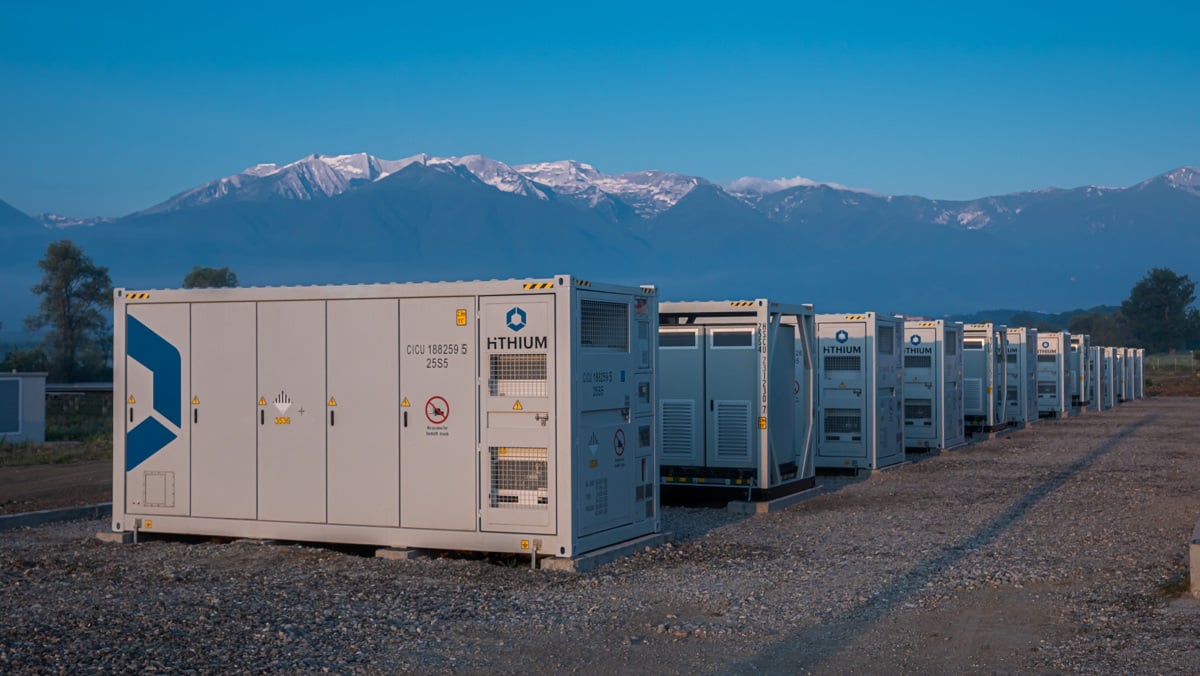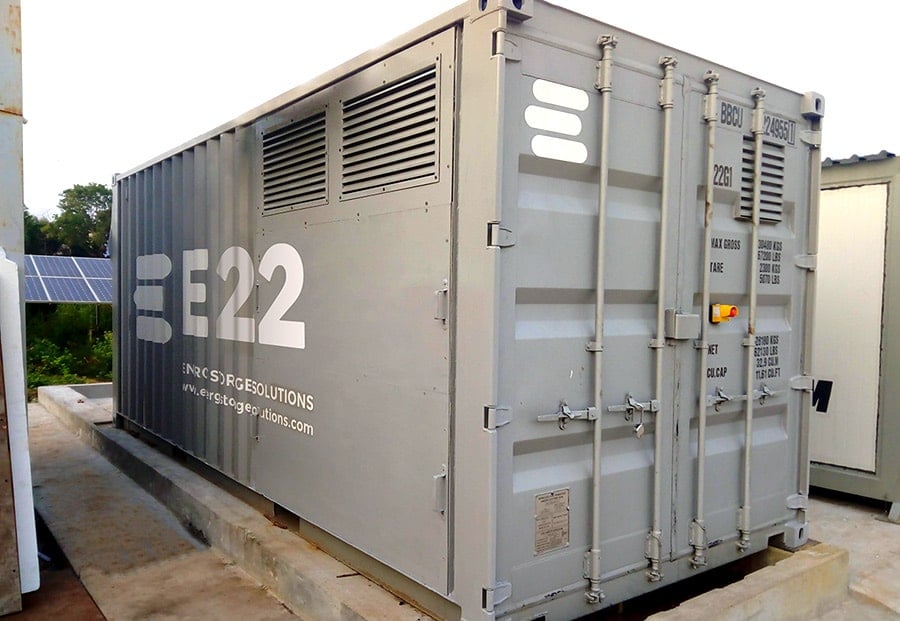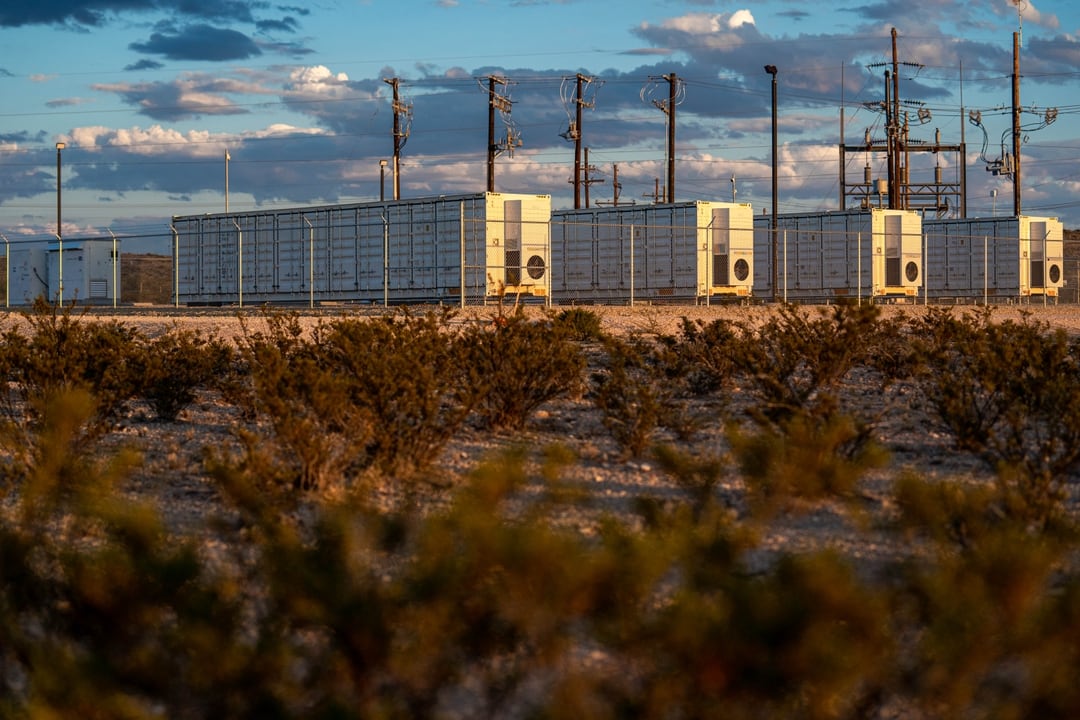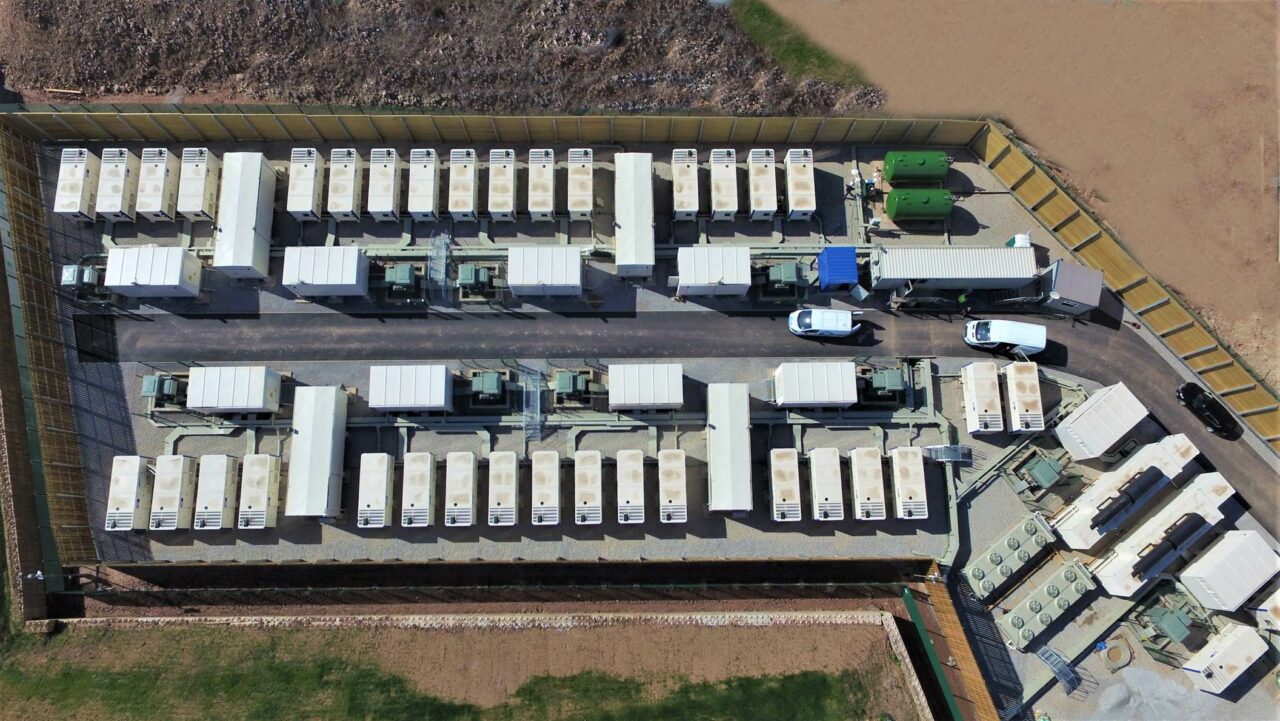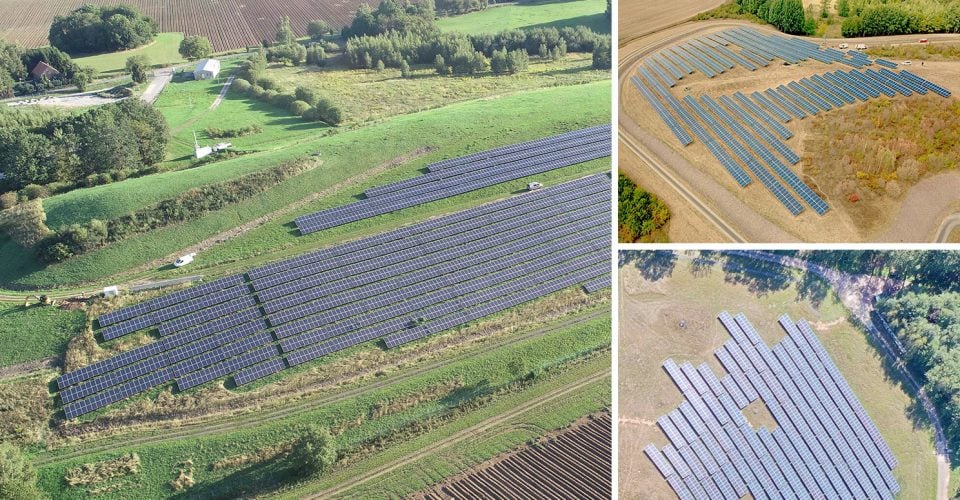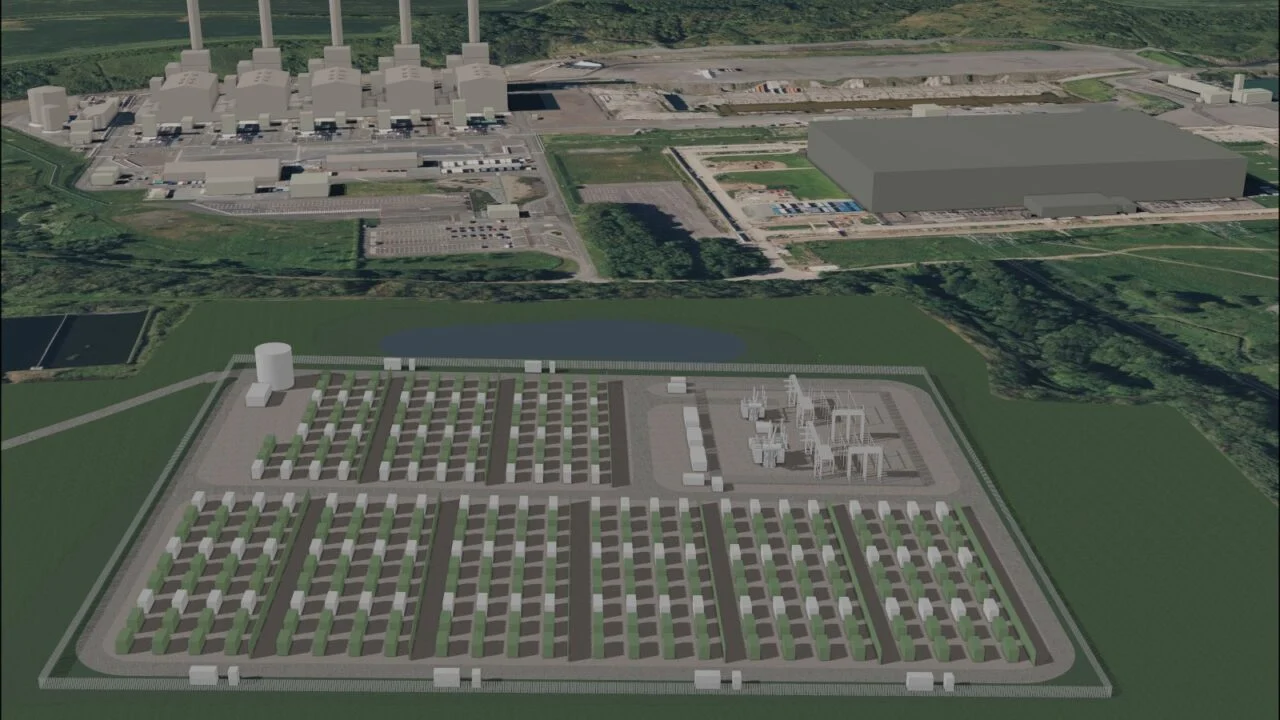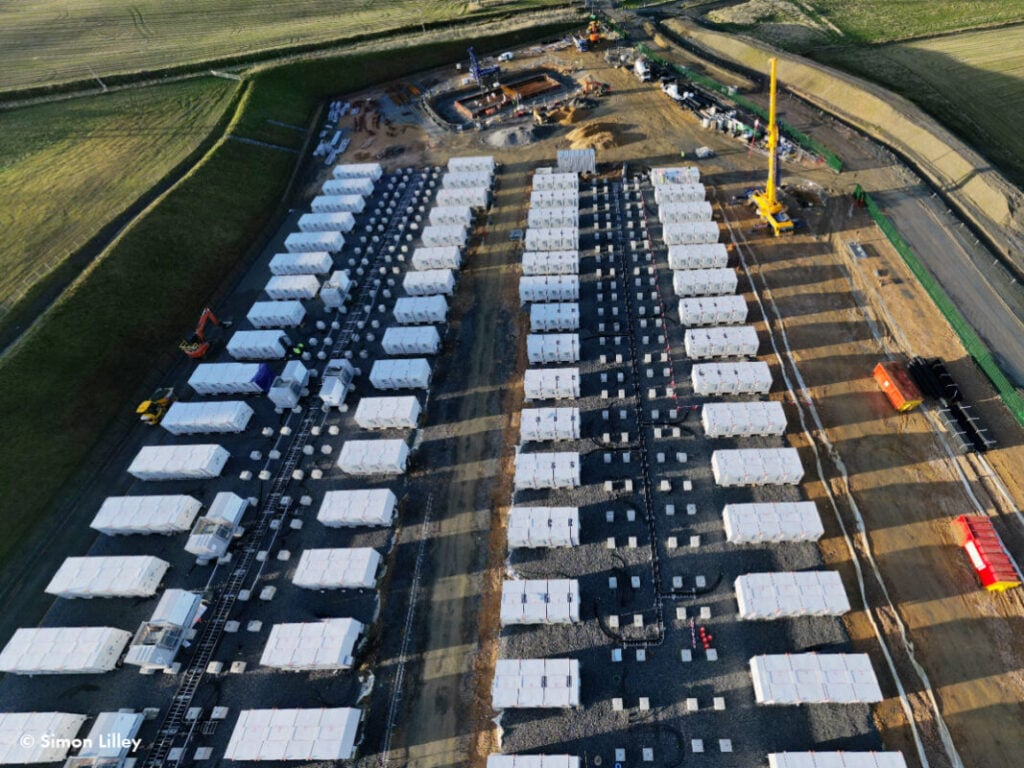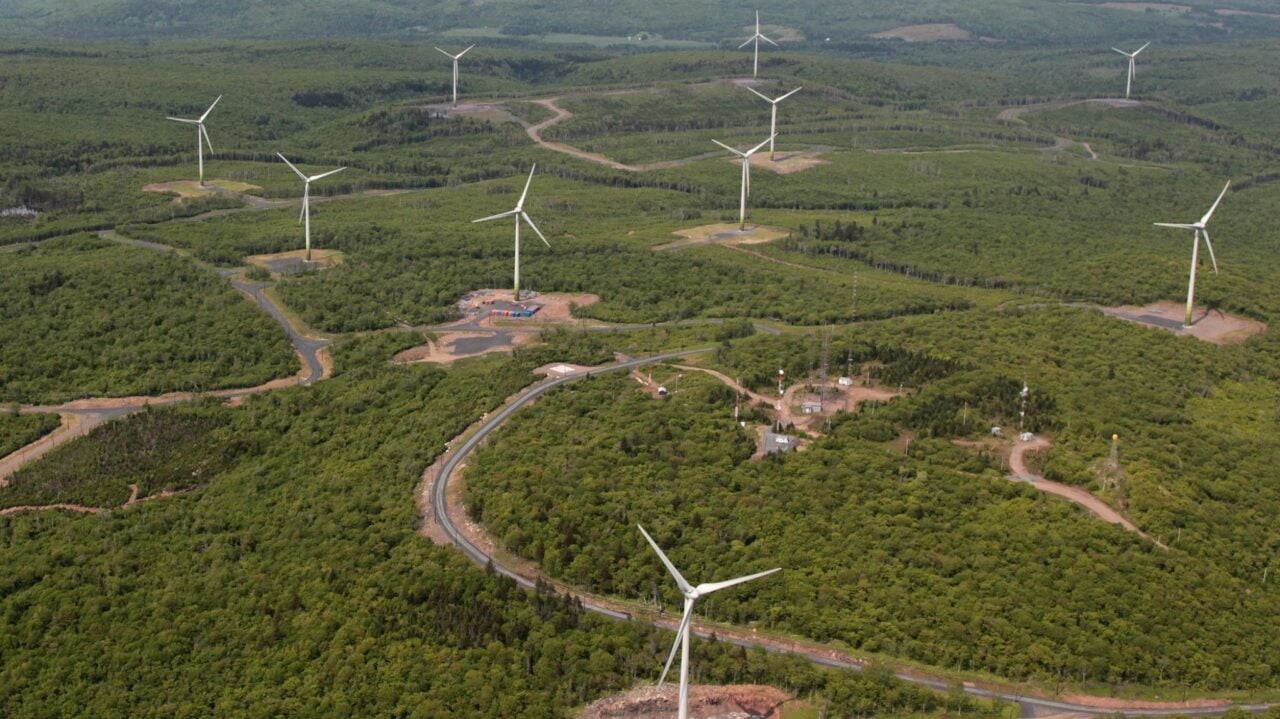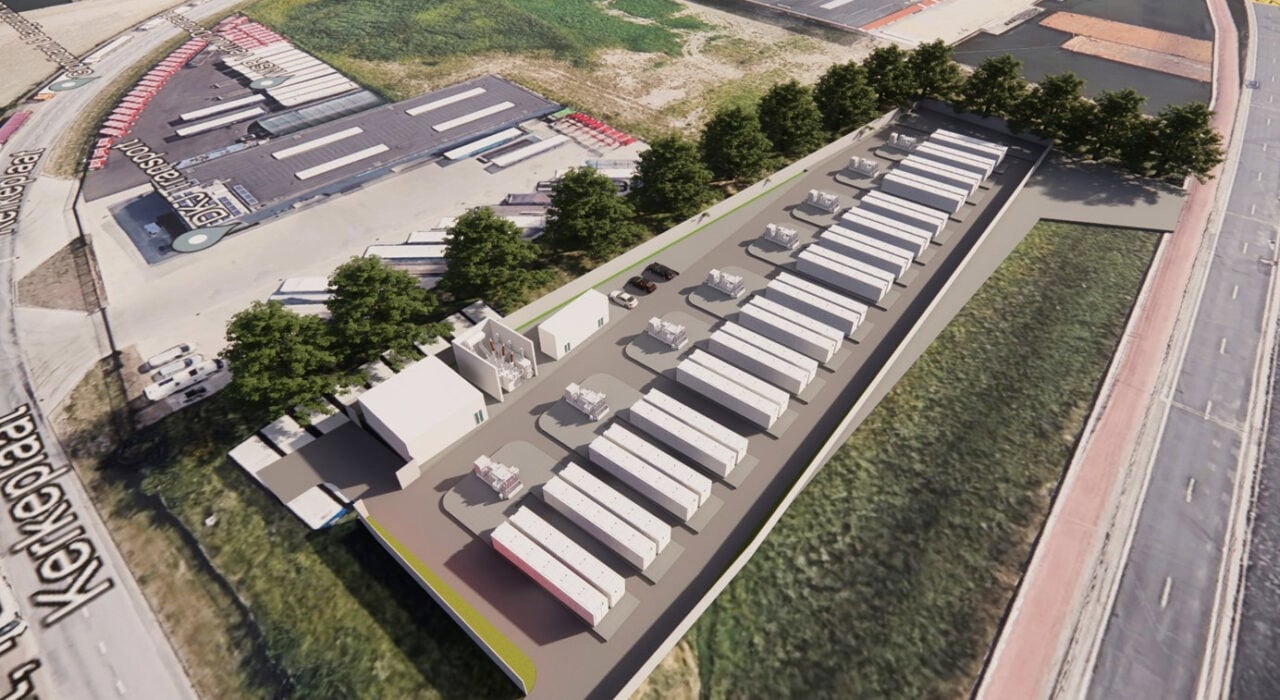The BESS will shift the renewable generation to the evening hours and trade energy on the market, and the trading and optimisation service will be provided by utility KER Toki Power. Its stored energy will be played into the capacity and balancing markets, and participate in pan-European ancillary services markets including aFFR and mFFR frequency response grid services.
Austria-headquartered Renalfa IPP is a joint venture between a subsidiary of engineering procurement and construction (EPC) and operation and maintenance (O&M) firm Solarpro Holding and French infrastructure investor RGreen Invest.
The BESS technology was provided by energy storage-focused lithium-ion OEM and BESS firm Hithium and power solutions firm Kehua Tech, both based in China. Hithium won the contract back in November last year, as reported by Energy-Storage.news at the time.
Nick Antonov, spokesperson for Renalfa IPP, said: “This co-located utility scale battery marks the start of hybridisation of our over 1GW portfolio of renewable assets in operation and in construction. We are about to introduce similar solutions in the other wind and PV assets in the region, including Hungary and Romania.”
“The main goal is to fully mitigate the PV profile risk of the generators. In the wider context of the energy transition, this facility demonstrates how advancements in technology are making renewable generation far more useful, dispatchable and flexible to supply and demand,” Antonov said.
It comes after local news outlets reported that another independent power producer (IPP) Vinali Re submitted plans for a hybrid wind, solar and storage project near Dobrich in northeastern Bulgaria.
In March, the country’s Ministry of Energy launched tenders for around 1,425MW of renewable generation projects along with 350MW of BESS.
The Renalfa IPP project in Razlog has been claimed as the biggest project of its type in Bulgaria. It is also larger than the biggest project to come online so far in neighbouring Romania, a 6MW/24MWh BESS in that country’s Constanta County, co-located with solar PV and wind generation plants. That project, by developer Monsson Group and system integrator Prime Batteries Technology was notable in that battery equipment and system integration was provided by Prime Batteries.
Marcin Wasilewski, CEO of the European Institute of Innovation & Technology (EIT) InnoEnergy in Central and Eastern Europe claimed the Constanta project was proof European ESS and battery companies could “successfully challenge their Asian and global competitors,” while Prime Batteries CEO Vicentiu Ciobanu said the project would be expanded to 215MWh capacity next year.
Monsson’s head of M&A, Sebastian Enache, and energy storage project manager, Mihaela Popescu spoke to Energy-Storage.news Premium about the Romania project for an interview published in May.
Meanwhile, Renalfa IPP’s portfolio and pipeline of wind, solar and BESS projects in development, construction and operation in Bulgaria, Romania,, Hungary, and North Macedonia totals roughly 2GW, with 455MW in operation and over 550MW in construction.
Energy-Storage.news’ publisher Solar Media will host the 2nd Energy Storage Summit Central Eastern Europe on 24-25 September this year in Warsaw, Poland. This event will bring together the region’s leading investors, policymakers, developers, utilities, energy buyers and service providers all in one place, as the region readies itself for storage to take off. Visit the official site for more info.
TWAICE, NARDAC partner to provide better insurance terms for BESS using software analytics
According to a statement released by the two companies, the energy storage industry has struggled to secure insurance coverage. High-profile incidents of thermal runaway have led insurers to reduce available capital.
Despite recent research by the Electric Power Research Institute (EPRI) and Pacific Northwest National Laboratory (PNNL) showing that BESS failure incident rates dropped 97% between 2018 and 2023, the severity of thermal runaway events remains high, leaving insurers exposed to high-cost claims, TWAICE said.
Stephan Rohr, CEO of TWAICE, stated that the partnership will enable the organisation to “offer tangible financial benefits to the entire energy storage markets” with its technology able to “lower the risk of a safety incident” through its autonomous monitoring and analytics.
Accompanying the announcement was a whitepaper named Thermal Runaway Mitigation for BESS Insurers. The document includes three real-world case studies whereby the use of its software analytics helped identify an issue with the asset alongside a TWAICE recommendation. The projects included were a 57MWh BESS, a 24MWh asset and a 22MWh storage system.
The 22MWh BESS received a ‘critical’ issue with the container suddenly heating up. The whitepaper stated that a “likely thermal runaway event was avoided because the client took action based on TWAICE Analytics recommendations”. TWAICE sent out a critical warning by e-mail each time the threshold of 40°C was reached – lower than the maximum temperature the asset could reach.
The client was recommended to change BMS settings for the system and to review settings in the other systems in the portfolio.
ACCURE discusses insurance innovations
In a similar move in April 2024, German-headquartered provider ACCURE partnered with UK BESS investor-developer Gore Street Energy Storage Fund to deploy cloud-based battery data analytics software to reduce operational issues and the risk of fires caused by thermal runaway events. This was to help businesses leverage analytics solutions to get improved insurance terms.
Last month (28 May) Energy-Storage.news hosted an exclusive webinar with ACCURE, PIB Insurance Brokers and insurance provider HDI Global, examining how data analytics can change the dynamics of insurance for large-scale BESS projects.
India’s biggest power producer NTPC tenders for 3MWh flow battery at research facility
The system would be deployed at NTPC’s R&D centre, NTPC Energy Technology Research Alliance (NETRA), which is in the Greater Noida region of Uttar Pradesh, India.
NETRA was set up in 2009, focusing on in-house technology development as well as collaborative research activities. Ongoing projects include carbon dioxide capture from flue gas produced by coal-fired power plants for conversion to methanol, solar PV and battery microgrids and high-pressure steam electrolysis for hydrogen generation.
Vanadium redox flow batteries are a contender for providing bulk electrochemical storage of energy at large capacities and longer durations versus lithium-ion (Li-ion) batteries, enabling the decoupling of energy and power at stack level.
In other words, to scale up the capacity of a flow battery, the system’s liquid electrolyte tanks can be increased in size, whereas with Li-ion, additional battery stacks need to be added, with attendant increases in cost and footprint as additional balance of plant (BOP) equipment such as inverters or power conversion systems (PCS) must be added. Vanadium flow batteries are also decoupled from supply chains for lithium-ion.
Therefore, while NTPC’s VRFB tender is much smaller in size than the company’s recent Li-ion battery energy storage system (BESS) solicitations (a 500MWh tender for standalone Li-ion BESS is currently ongoing), it represents an R&D effort to evaluate the flow battery technology.
‘Start of something big’
As with other parts of the world, VRFBs are at an earlier stage of commercialisation in India than lithium-ion BESS or pumped hydro energy storage (PHES).
Only a handful of examples of installed projects exist in the country, such as a 50kW/200kWh VRFB provided by Spain-headquartered E22 to state-owned enterprise Bharat Heavy Electricals Limited (BHEL) commissioned in Hyderabad in 2022.
Vishal Mittal, founder of Deletrik Systems, thought to be the only VRFB OEM headquartered in India at present, welcomed the NTPC tender as the first of its kind at MWh scale in India.
“This could be start of something big and go a long way in meeting India’s domestic BESS requirement of 236 GWh by 2031-32 as per the National Electricity Plan projection,” Mittal wrote on networking site LinkedIn yesterday.
NTPC is seeking bidders which have been substantially involved in the delivery of VRFB systems from a manufacturer perspective, with a cumulative capacity of 2,400kWh in one to five orders over the past 10 years. Manufacturers should provide evidence of at least one reference project of 400kWh or larger in operation for at least six months ahead of the tender’s opening for bids on 9 July 2024.
EPC firms taking part should partner with VRFB manufacturers and have delivered a grid-connected solar PV project or off-grid solar-plus-storage hybrid project with a value of more than IR114 million (US$1.37 million), in operation for at least six months prior to bid open.
Invinity wins EDF Renewables North America flow battery contract for microgrid
In related news, Anglo-American VRFB provider Invinity Energy Systems this week (17 June) announced a 4MWh sale to EDF Renewables North America subsidiary PowerFlex in California.
18 Invinity VS3 VRFB units will be deployed at a solar PV microgrid project for the indigenous community Rincon Band of Luiseño Indians, at its Harrah’s Resort Southern California resort complex, paired with new and existing solar PV capacity.
The project is among a number of similar projects for Tribal communities being funded through the California Energy Commission (CEC), with Invinity involved in some of the others, aimed at giving communities greater energy resilience and higher integration of renewable energy. Projects are based on a variety of energy storage technologies including lithium-ion and flow batteries, with a significant component around funding for novel LDES technologies.
Invinity recently announced an expansion in manufacturing capacity in Scotland, UK, where it will build a new assembly plant for its VRFBs, as well as expanding an existing cell stack production plant. This will bring its annual flow battery production capacity in the UK to more than 500MWh, while the firm also has a 700MWh annual production capacity factory in Canada.
Jupiter Power unveils plan for 700MW BESS at former ExxonMobil oil depot in Massachusetts
Jupiter Power has launched a website for the project that has yet to be pushed live. This is standard practice for Jupiter Power which creates individual websites for many of its developments including its proposed 85MW Prairie Flyer Energy Storage project in Montgomery County, Ohio.
Brownfield site development
Jupiter Power’s proposed Trimount project is part of a wider redevelopment programme at the former ExxonMobil site in Everett, Middlesex County, Massachusetts.
Real estate developer Davis Companies purchased the 100-acre site from ExxonMobil in January 2024 following a lawsuit and settlement agreement with non-profit organisation Conservation Law Foundation (CLF).
The oil major was forced to close the Everett oil depot after the agreement stipulated the site could no longer be used to store petroleum products.
Following Davis Companies’ acquisition, the Massachusetts Attorney General’s Office entered into an agreement with the real estate company for the environmental remediation and redevelopment of the former tank farm site.
The agreement, announced 30 May 2024, provides liability protection to Davis Companies in exchange for its commitment to redevelop the brownfield site. The formal agreement between the two parties describes the brownfield site as being “heavily contaminated with oil” and “industrial chemicals formerly used in the site operations.”
1.6GW of battery interconnection requests at Mystic Substation
The Trimount project will connect to the local electricity grid via Eversource Energy’s Mystic Substation, a highly sought-after point of interconnection according to ISO New England’s public interconnection queue. Six separate requests to interconnect battery storage projects to the Mystic Substation total over 1.6GW of capacity.
Only one of the six battery storage projects seeking permission to connect to Eversource’s Mystic Substation is identifiable at this stage: Norman Street Battery Storage. Unlike other interconnection queues throughout North America (such as CAISO and ERCOT), important details such as a project name are only attributed to queue requests in New England at a later stage of development, meaning it can often be challenging to identify owners of certain queue positions.
Documents filed with ISO New England in July 2022 reveal that Jupiter Power is the owner of the Norman Street Battery Storage queue position (no. 1110) after the New England system operator determined that the project would not have significant adverse effects on the local grid.
The naming convention and interconnection request timeline for the Norman Street queue position suggest that this project is separate from Jupiter Power’s proposed Trimount development, and will be located on Norman Street approximately 0.5 miles northwest of the former ExxonMobil site.
Austin, TX-headquartered Jupiter Power has one of the largest operational battery storage fleets in ERCOT and claims to have a development pipeline of over 11GW in battery storage capacity across the United States.
In related news, fellow developer Plus Power recently closed financing on a 150MW/300MWh BESS project in Massachusetts which the company claimed will be the first large-scale standalone battery storage system to connect to the ISO New England grid.
Plus Power is targeting the completion of its Cranberry Point BESS, which won a contract in an ISO New England Forward Capacity Auction (FCA), in Q2 2025.
Jupiter Power’s 275MW New York BESS development
Elsewhere in the US, Jupiter Power recently held an open house to provide information to concerned local residents regarding its proposed 275MW Oyster Shore Battery Storage project which is set to replace an oil terminal owned by Global Partners in Nassau County, New York.
Under its Juno Power Management, LLC subsidiary, Jupiter Power submitted an interconnection request (queue no. 1431) with NYISO back in September 2022 for the project which will connect to the grid via Long Island Power Authority’s (LIPA’s) Shore Road 138kV Substation.
Local petition
Residents have voiced their concerns surrounding the proposed battery development with one online Change.org petition asking Oyster Bay Supervisor Joseph Saladino to halt the project entirely. The petition, currently at 1700 signatures, focuses on the risk of battery fires and even cites details of a fire that occurred last year at one of Convergent Energy + Power’s battery storage facilities in Warwick, New York.
Although only small at this stage, online petitions speaking out against battery storage developments have gained momentum in the past, including one last year speaking out against a battery microgrid project proposed by Rev Renewables and National Grid in Raquette Lake, New York, which garnered the support of over 27,500 local residents.
National Grid issued a statement in February of this year saying that it, along with Rev Renewables, had made the decision to cease development of the Central Adirondack Microgrid Project after carrying out “extensive community engagement.”
‘We will maximise value of the assets’: Octopus Energy on Gresham House BESS toll deal
The deal is a significant departure from how BESS are typically monetised in the UK, and the dynamics leading up to it were explored in our coverage at the time.
Kieron Stopforth, Octopus’ head of flexibility, discussed how the BESS portfolio will be a complement to its existing flexibility assets, helping lower prices for consumers, and the company’s strategy for maximising their value, starting with the primary rationale for the deal.
Batteries are an ‘at-scale’ form of flexibility
“Low-carbon flexibility is absolutely critical for the system of the future, to manage and bring down system costs, bring down bills and reduce curtailment. We are focusing on increasing that in all forms and sources, and batteries are a good source for doing that at scale,” Stopforth said.
The portfolio will go alongside a round of flexibility assets that Octopus Energy already has in its virtual power plant (VPP), but has some advantages compared to those assets. That VPP includes home electric vehicles (EVs), heat pumps, small-scale solar and storage adding up to around 1GW of intelligent demand that can be shifted around, on top of demand-side response programmes like the Demand Flexibility Service (DFS).
Stopforth: “The profile and shape of flexibility is different from technology to technology. When you are optimising EVs, you need to make sure they are charged when they need to be, for example. BESS is less distributed, larger scale and not as constrainted in that way, so it’s a really good source of flexibility.”
“The domestic fleet is about minimising costs for consumers. BESS do that in aggregate, but the jobs are different.”
The BESS will connect to Octopus’ KrakenFlex Energy Flexibility Management Platform.
The toll deal
We asked Stopforth how the projects for the deal, covering 70-80% of GRID’s operational portfolio, were chosen. For example, does it cover any operational project without a live optimisation contract?
“In terms of asset selection and choice, we approached it looking at a range of different sizes, geographical distribution, duration; basically a number of things to get diversity across the portfolio,” Stopforth said.
He said the toll is not usage-based, with a price per MW giving Octopus dispatch and revenue rights over the assets.
Gresham House said that the deal, plus separate Capacity Market (CM) obligations the BESS projects have to fulfil, is worth £43 million (US$55 million) a year over its two-year lifetime. The tolling deal will almost certainly be the majority of that, with Gresham House in the past saying the CM would be 5-15% of BESS revenues in the long term.
How Octopus will manage the BESS’ activity
Stopforth explained that the BESS will be managed by a combination of Octopus’s Kraken platform and Octopus’s in-house energy trading team. The dispatch and controls piece will be more on the Kraken side, and the energy trading expertise will be primarily in the Octopus team. “It’s a very integrated and relationship-driven system.”
One big question is whether BESS’s market activity might change under Octopus’ management. In the UK, BESS generally gets a majority of revenues from participating in electricity market operator National Grid ESO’s various ancillary services, plus some energy trading and the Balancing Mechanism (BM), though there is a shift to more of the latter.
“It’s our job to try and get the most value from these batteries and assets and, to that, end fulfilling the flexibility function, reducing system costs and reducing curtailment. Within that specific strategy and the specific markets, we are fairly indifferent to which markets we bid into. We are trying to maximise value for the projects,” Stopforth said.
“What we’ve seen recently is a shift in value to more wholesale applications. The BM has dispatched a bit more, for example. In terms of individual revenue streams, we have quite a flexible strategy.”
We then asked if utilities have an advantage over third-party optimisation firms when it comes to the more energy trading-intensive activities like the BM.
“The key difference for utilities is having a retail book and trading and hedging on that. Batteries can be helpful and can play a role helping some of the risks there. But everyone is trying to do the right thing and maximise value. How that looks in practice might not be that different. But the composition and internal synergies, that logic is slightly different for utilities.”
Utilities being more involved in BESS a net gain for the energy storage market?
Energy storage industry sources tell Energy-Storage.news that a big challenge in all geographies is having the technology’s value adequately recognised and accommodated in electricity systems, with storage still a very new type of resource.
As a final question, we asked Stopforth if utilities like Octopus becoming the BESS operators might help this process along. Presumably, Octopus has both a better understanding of the whole system and better access to dialogue with the key decision makers behind it, compared to optimisation startups, which have to date been the main entities managing BESS activity in the UK.
“These are very big conversations and the decisions that we make now are going to influence the way the energy system is designed over the next 10, 20 years. It’s critical we get it right,” he said.
“As a tech-focused utility, we are able to take a very broad view of how the system should work, how you run it, but most critically, we can work as an advocate for customers in doing things that will help us meet low carbon without increasing customers bills. As Octopus, we see that big picture through a very integrated operation.”
“When we talk to ESO and other stakeholders we are coming from that point of view, but critically that customers are at the heart of it, making sure we keep bills down while enabling this low carbon future.”
Alongside being the UK’s largest utility with around seven million customers, Octopus Energy also has a generation arm which is active in clean energy project development and operation internationally. That includes BESS projects in Italy and Australia, as well as solar PV in Germany, Iberia and elsewhere, the latter covered by our colleagues at PV Tech.
Eneco’s LichtBlick and developer Energisto expect 400MWh of Germany BESS approvals this year
The move into BESS is a new area for both companies, with Energisto having primarily developed solar and LichtBlick already owning its own solar PV generation plants but not yet energy storage. They expect building permits for BESS projects with a total capacity of up to 400MWh to be issued this year.
Germany has ambitious renewable deployment targets to achieve a goal of 80% renewable energy by 2030, including 215GW of solar PV by that date, which is driving the need for large-scale energy storage to balance supply and demand and shore up grid stability.
“The economic added value of large battery storage systems is enormous,” said Dr. Enno Wolf, LichtBlick COO.
LightBlick is a utility that claims to provide 100% green electricity, and is part of Netherlands-headquartered utility Eneco.
The firm’s announcement indicated that Eneco may use its energy trading platform to monetise the BESS projects once operational, pointing out that Eneco already does that in Germany, Belgium and the Netherlands and that its remuneration model is “financeable and offers secure revenues”.
Just yesterday, Energy-Storage.news reported on a BESS project in the Netherlands that Eneco will effectively rent from owner Dispatch and trade in the market via a toll agreement.
LichtBlick also commended the Federal Ministry for Economic Affairs and Climate Action of Germany (abbreviated as BMWK) for its Electricity Storage Strategy to reshape the electricity system to help facilitate large-scale energy storage on the grid.
“The current framework counteracts the exploitation of the potential of large-scale battery storage systems,” Wolf added. LichtBlick has a total clean energy project pipeline of around 4,000MW via multiple development partnerships.
The JV with Energisto is not LichtBlick’s first announced foray into energy storage. It is co-developing and financing a large-scale compressed air energy storage (CAES) project with Corre Energy, set to start operations in 2027, via a deal agreed in January.
RWE opens community consultation on 350MW battery storage project in Wales, UK
A pre-application consultation period has begun; members of the local community can provide feedback on the proposed planning application until Monday, 15 July. RWE emphasised its commitment to environmental responsibility, noting that the proposals include plans for planting species-rich meadows, native woodland and scrub planting, and a new large pond to support local wildlife.
Commenting on the proposals, Richard Little, Pembroke Net Zero Centre director, said: “RWE Pembroke Battery represents the next step in our plans to invest in new innovative energy technologies, as part of our vision for Pembroke Net Zero Centre. We would like to thank those who engaged with us in our Green Hydrogen consultation and encourage the community to get involved with the consultation process, learn more about our battery energy storage proposals, and have their say on the proposals.”
To read the full version of this story, visit Solar Power Portal.
Solar Media Market Research’s UK Battery Storage Project Database Report features comprehensive data on the pipeline of BESS projects from planned to operational. To learn more, visit the Solar Media Market Research website.
Grid-forming technology and its role in the energy transition
In the quest for stable power systems, ensuring grid stability is paramount, particularly with the increasing integration of volatile renewable generators such as PV and wind. Grid stability relies on the dependable provision of essential grid services such as frequency response (FRT), voltage stability, and inertia.
Traditionally, synchronous generators provided these reserves at the transmission system level. However, the emergence of large-scale battery storage technology presents an alternative solution.
Battery storage offers rapid delivery of stored power and energy, outperforming conventional synchronous power plants in terms of response time and efficiency. With its impressive technical performance and increasing commercial competitiveness, battery storage is poised to play a pivotal role in future power systems with 100% renewable penetration.
Global solar inverter manufacturer SMA has utilised advanced power conversion systems (PCS) and control technologies that have significantly contributed to grid stability by encompassing inverters, medium voltage solutions, plant control and engineering services.
The provision of grid-following inverters proved instrumental in maintaining operational continuity and ensuring an uninterrupted power supply during severe grid disturbances in Odessa in 2021 and 2022.
Additionally, advanced grid-following controls have proven effective even in weak grid environments, as demonstrated in the West Murray region of Australia.
This article explores the pivotal role of advanced inverter and control technology, especially concerning grid stability.
Understanding grid-forming technology and its evolution
Developing the grid-forming solution was not merely about replicating a synchronous generator; instead, the focus was on preserving relevant features and emphasising beneficial capabilities. This approach diverged from the conventional term “virtual synchronous machine,” as the goal was to enhance functionality beyond traditional methods.
In the initial stages of discussions, there were doubts about the feasibility of grid-forming technology. Demonstrators, such as the one on the island of St. Eustatius in the Caribbean Sea, played a crucial role in dispelling these concerns.
Software (SW) plays a pivotal role in grid-forming operation, where grid parameters are stabilised in response to deviations. This involves adapting island grid SW to react to frequency gradients instead of frequencies for grid-tied operation, resulting in a unique combination of droop and inertia control. This approach ensures stability and resilience, allowing inverters to emulate the behaviour of synchronous machines effectively.
Hardware (HW) enhancements are also integral to grid-forming solutions. Given that grid-following inverters typically offer limited short-circuit level (SCL) contributions compared to synchronous condensers, SMA’s Large Scale Hardware incorporates a short-term boost capability. This involves improving thermal management and providing design headroom for short-term overload, ensuring grid-friendly behaviour across various operational conditions.
By harnessing the stability and flexibility of battery energy storage systems, grid-forming solutions offer a pathway to a more sustainable and reliable energy future.
These solutions for grid-forming on-grid applications ensure seamless integration of renewable energy sources while maintaining grid stability. The emergence of additional stability services like inertia, system strength, and islanding capabilities underscores the necessity for grid-forming (GFM) controls at both inverter and plant levels.
Grid-forming projects in Australia: A key use case
Australia’s ambitious federal goal of achieving 82% renewable energy generation by 2030 has propelled the nation to the forefront of renewable energy adoption. With a vast potential for wind and solar energy, Australia faces the challenge of integrating these intermittent energy sources into its grid seamlessly. Battery energy storage systems (BESS) equipped with grid-forming technology have emerged as essential components to enable the required grid-hosting capacity for renewable energy.
Australia’s unique energy landscape offers valuable insights into the future of energy supply and grid stability. As an islanded power system with extensive distances for power transmission and high renewable energy penetration, Australia encounters challenges that other regions may face in the future.
Recognising the importance of grid-forming technology in enhancing grid stability and resilience, the Australian Renewable Energy Agency (ARENA) has allocated substantial funding to support grid-connected BESS projects with GFM capabilities.
The deployment of robust GFM technology is crucial for the Australian grid’s progression, as outlined in the Integrated System Plan released by the Australian Energy Market Operator (AEMO).
With a shift towards renewable energy sources connected to the grid through inverter-based resources (IBR), traditional IBR without grid-forming technology fall short in providing adequate grid support services. Grid-forming functionality is essential to address this gap, enabling IBR coupled with BESS to contribute to network strength and stability.
Advantages of grid-forming inverters over traditional solutions
Grid-forming inverters offer several advantages over traditional synchronous generators. Firstly, they behave similarly to synchronous machines, acting as a voltage source behind an impedance without the physical constraints associated with rotating machinery.
This enables them to independently create their own three-phase voltage vector with a balanced sinusoidal waveform, reacting promptly to grid disturbances. Unlike grid-following assets, grid-forming inverters represent a true voltage source rather than a current source.
One significant advantage lies in the control capabilities of grid-forming inverters. Advanced grid-forming controls enable these inverters to exhibit synchronous, inertial, and damping behavior of the voltage vector. This results in an instantaneous, delay-free power response to grid events.
Moreover, the parameters of this response, including voltage amplitude, phase angle, and frequency, are adjustable. This flexibility allows for tuning of characteristics such as damping behaviour over the lifetime of the asset, enhancing its performance and adaptability.
Additionally, integrating electrochemical battery storage with grid-forming inverters further enhances their versatility and cost-effectiveness. Battery storage replaces the rotating mass traditionally used for mechanical storage in synchronous machines.
As a result, grid-forming inverters combined with battery storage can provide not only inertia and short-circuit-level (SCL) but also capacity for congestion management and other ‘traditional’ energy services. This multi-purpose functionality makes grid-forming inverters with battery storage a highly efficient and adaptable asset.
Furthermore, the introduction of current boost capability by SMA eliminates the last remaining advantage of synchronous condensers, ensuring a high firm response at rated power. This capability enhances the performance of grid-forming inverters, making them even more competitive and suitable for various applications.
Blackhillock: A case study
Project overview
A world first, the Blackhillock project stands as a groundbreaking initiative in Scotland, spearheaded by developer Zenobē Energy, to propel the UK towards a net-zero economy.
The project’s state-of-the-art inverters, power stations, and advanced control systems deliver vital grid services, marking a significant advancement in renewable energy integration.
Key objectives
The primary aim of the Blackhillock project is to enhance system stability in the most cost-effective manner for consumers. Leveraging grid-forming technology and battery energy storage, the project targets to boost grid resilience, curtail carbon emissions, and reduce consumer bills. Additionally, it aims to bolster inertia and short-circuit levels at crucial interconnection nodes, thereby enhancing the overall reliability of the electricity grid.
Implementation and outcome
Phase 1 of the Blackhillock project, comprising 200MW is planned to be commissioned in the summer of 2024, with Phase 2, an additional 100MW, slated for completion in the latter half of 2026. Upon completion, it will be the largest transmission-connected battery in Europe, offering a comprehensive suite of active and reactive power services. By facilitating greater integration of wind power into the transmission network, the project is projected to prevent approximately 2.3 million tonnes of CO2 emissions over 15 years.
Key technologies and partnerships
A closer look at Blackhillock. Image: Zenobē Energy
SMA supplied critical components for the project, including 62 medium-voltage power stations boasting 333MWs of inertia and 84 MVA of SCL. Collaborating with industry leaders like Wärtsilä and H&MV, Zenobē ensured the successful implementation of the project, setting new benchmarks in grid stability and renewable energy integration.
Zenobē, SMA and Wärtsilä are partnering again for a comparable project located in South Kilmarnock, also Scotland. This new endeavor aims to surpass previous performance with an impressive power output of 300MW, coupled with 1,314MWs of inertia and 249MVA of SCL capacity.
Summary
The Blackhillock project not only represents a significant milestone in maintaining grid stability based on inverter-based resources (IBRs) but also in the UK’s journey towards achieving net-zero emissions.
Leveraging innovative technologies and forging strategic partnerships, Zenobē and SMA are helping showcase the transformative potential of energy storage in revolutionising the electricity grid.
As the Blackhillock and Kilmarnock projects evolve, they will serve as a beacon of sustainable energy development, propelling the UK closer to its renewable energy objectives while ensuring a stable, cost-effective, and environmentally friendly energy future.
Economic considerations and cost analysis
While the initial investment in grid-forming technology may be higher than traditional solutions, the long-term benefits far outweigh the costs. Grid-forming inverters offer enhanced grid stability and reliability, significantly reducing the risk of grid outages and downtime. This translates into substantial savings in terms of avoided losses due to power interruptions and improved operational efficiency.
Moreover, the flexibility afforded by integrating battery energy storage systems with grid-forming technology enables dynamic response to changing grid conditions. This optimisation of energy efficiency and grid performance leads to additional cost savings over time. With renewable energy penetration on the rise, grid-forming technology becomes increasingly indispensable for ensuring grid stability and resilience in the face of fluctuating renewable energy output.
Grid-forming inverters offer enhanced grid stability and reliability and provide the opportunity for revenue generation through ancillary grid services and participation in energy markets.
The chart below shows three different design examples of a grid-forming asset:
By leveraging advanced control algorithms and innovative hardware designs, grid-forming inverters for on-grid applications deliver superior performance and reliability compared to traditional solutions. This ensures optimal grid stability and resilience, making them a cost-effective and future-proof solution for modern power systems.
Final thoughts and future outlook
As renewable energy penetration increases worldwide, grid operators, policymakers, and industry stakeholders must collaborate to address the challenges and opportunities posed by this transition. By embracing stability services markets, grid-forming solutions and investing in robust grid infrastructure, we can build more resilient and adaptable energy systems capable of meeting the demands of a rapidly changing world.
Furthermore, ongoing research and development efforts are essential to further refine and optimise grid-forming technology, enhancing its efficiency, reliability, and scalability. By harnessing the collective expertise and innovation of the global energy community, we can accelerate the deployment of grid-forming solutions and unlock new possibilities for a cleaner, more sustainable energy future.
This is an extract of a feature article that originally appeared in Vol.39 of PV Tech Power, Solar Media’s quarterly journal covering the solar and storage industries. Every edition includes ‘Storage & Smart Power’, a dedicated section contributed by the Energy-Storage.news team, and full access to upcoming issues as well as the 10-year back catalogue are included as part of a subscription to Energy-Storage.news Premium.
About the Author
Aaron Philipp Gerdemann is a senior business development manager in SMA’s Large Scale and Project Solutions Segment. For the past 2.5 years, he has guided TSOs, IPPs and developers towards the understanding and deployment of stability services from battery inverter solutions to their power systems and assets, such as the Grid Booster in Germany and the Stability Pathfinder projects in the UK.
Nova Scotia regulators approve CA$354 million BESS portfolio in Atlantic Canadian province
NS Power is privately owned by holding company Emera but is regulated by the province via NSUARB and must apply for regulatory approval for any capital spend over CA$1 million (US$0.73 million).
Capital cost to NS Power’s customer base will be a total of approximately CA$243 million. This comprises a portion of the total expected cost of the 150MW BESS buildout, which is CA$354 million, including Allowance of Funds Used During Construction (AFUDC), where the capital cost of financing construction is added to the total value of the assets.
The Canadian federal government has also committed to contributing to financing the projects to the tune of CA$115.6 million, through Natural Resources Canada’s Smart Renewables and Electrification (SREP) programme which allows for up to a third of capital expenses up to CA$130 million to be funded.
BESS portfolio will enable integration of more than 1GW of wind
The 150MW/600MWh of battery storage will be sited at separate interconnection points to the grid, each asset with 50MW output to NS Power’s grid.
They will significantly contribute to the Atlantic Canadian province’s estimated need for around 300MW-400MW of energy storage by 2030, which will help Nova Scotia reach its 80% renewable energy policy target and coal power phaseout by that date.
With Nova Scotia still heavily reliant on coal-fired power generation, the provincial government’s clean energy plan unveiled in October last year found that renewable energy backed with storage would be the most cost-effective and fastest way to achieve decarbonisation goals.
Other options had included Atlantic Loop, a scheme to import hydroelectric power generated in Quebec, but the government modelled that renewables—mainly onshore wind—would be much cheaper and quicker to deploy.
Studies quoted by the Nova Scotia Department of Natural Resources and Renewables found the cost of onshore wind-plus-batteries to be between about CA$70-CA$100/MWh, onshore wind between CA$45-CA$60/MWh.
Atlantic Loop imports would cost about CA$200-CA$250/MWh and imports from neighbouring New Brunswick and Newfoundland about CA$150-CA$200/MWh. Atlantic Loop is still going ahead, but the Department considers it unlikely to be ready before the end of this decade, and its expected cost has spiralled upwards since 2020 from CA$3 billion to closer to CA$9 billion.
With this in mind, the Nova Scotian utility was ordered at the end of 2023 by the Department of Natural Resources and Renewables to procure the three lithium-ion (Li-ion) BESS assets.
The assets will enable the grid integration of more than 1,000MW of new wind resources, perform grid services and help manage the utility’s peak load.
NS Power then filed its 626-page capital cost approval application for the projects with NSUARB in late January 2024, with cost recovery to cover engineering, procurement and construction (EPC), commissioning and the start of commercial operation of the systems.
Legislative and regulatory groundwork was laid earlier last year with amendments to Nova Scotia’s Electricity Act that allowed NS Power to hold competitive solicitations to procure energy storage resources in March 2023.
Nova Scotia lacks access to good gas supply, being “at the end of the pipeline” in Canada, and jumping from coal directly to clean energy resources rather than coal to gas and then to clean energy would be the best “future-proofed approach,” independent consultant Patrick Bateman told Energy-Storage.news back in August 2023 as the province issued a progress report on its Environmental Goals and Climate Change Reduction Act legislation passed in 2021.
NSUARB’s decision can be read in full here (PDF).
Dispatch, Fluence and Eneco to deploy Netherlands’ largest standalone BESS
Fluence will provide 144 of its Cube grid-scale BESS products for the 2-hour system, which will be located in the port area of Dordrecht, near Rotterdam. The BESS will help balance supply and demand on the grid by storing excess renewable energy, Eneco said.
Financing for the project’s construction has been arranged between Dispatch and infrastructure funds EPICo² and Macquarie Capital, and bank ABN Amro and engineering, procurement and construction (EPC) contractor Equans Netherlands will oversee the construction.
Netherlands market
Eneco’s announcement did not say when the project was expected to come online. The largest operational BESS in the country today is a 30MW/68MWh system owned by developer-operator SemperPower, commissioned in late 2023. Note Fluence is also deploying a 35MW/100MWh BESS in the Netherlands for another utility Engie at a PV plant.
Large-scale BESS in the Netherlands have typically been commercialised by their owners via long-term tolling agreements where larger companies like utilities or independent power producers (IPP) rent a portion or all of a project in return for a fixed fee to the owner, and optimise the projects charge and discharge in the electricity market. That is different to the ‘merchant’ model of sharing risk between owner and optimiser.
The toll is the model opted for by both SemperPower and Netherlands’ next-largest BESS owner-operator Giga Storage. Eneco’s announcement did not specify this, but the fact it announced the project indicates that the toll model could have been used for this project too – a third-party optimiser would not typically be the company to announce a project that has been commercialised under a merchant model.
Energy-Storage.news has asked Eneco to comment on this and will update the article in due course.
The tolling model leads to more secure but potentially lower returns than the merchant model. The Dutch market has a ‘missing money’ issue as well as regulatory hurdles which Eneco has in the past called on its government to address. More recently, research firm Aurora told us last month that a move to flexibilise grid fees could boost BESS deployments.


